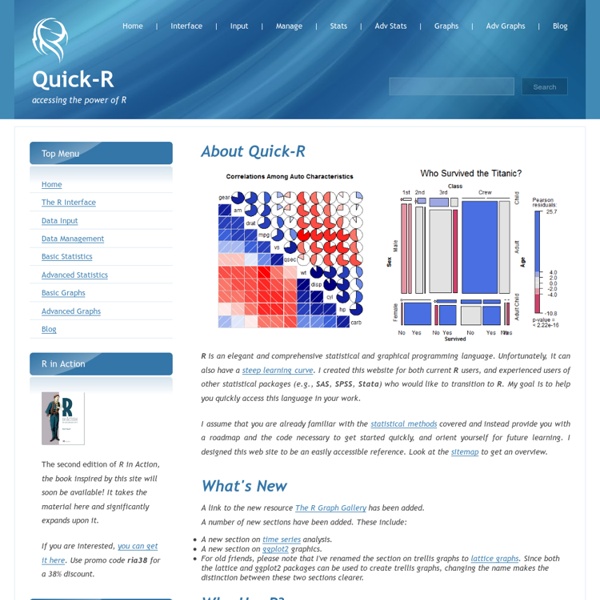



The R Project for Statistical Computing HlpLab/StatsCourses - CvsBcs Wiki All material posted here is subject to common sense copyright ;). That is, I'd appreciate if you cite if something is useful, and if you ask me before using materials in your classes ( fjaeger@bcs.rochester.edu ). This will also help to reduce damage whenever I (or someone else) discovers mistakes in any of the material. Feedback welcome. Thanks. Whenever I incorporated materials from others, this is mentioned in the slides. Two day statistics tutorial at McGill (5/2010) with Maureen Gillespie (Northeastern) and Peter Graff (MIT). Two 3h-lectures held at Penn State (2/2010). Materials for workshop on common issues and standard in ordinary and multilevel regression modeling in psycholinguistic data analysis (Florian Jaeger and Victor Kuperman; CUNY, March, 2009): assumes some prior familiarity with regression modeling.
GRASS GIS - R: Learning R statistical data language Short Introduction to Geostatistical and Spatial Data Analysis with GRASS and R statistical data language [Table of contents] DRAFT Document! Learning statistical data analysis using "R" The R examples described here are (should be) platform independent. 1. To start R, enter: (Windows: click onto the Rgui icon) R provides a set of base functions, which can be extended by using contributed packages (to be installed additionally). #don't get confused: the code package is called VR, the library MASS: install.packages("VR") library(MASS) To get R command help, you can always add a ? ? Additionally there is the FAQ). R is an object oriented data analysis language. To get the result, just enter the name of the object: Basics: Drawing a function A simple example is to plot a sine curve. x <- seq(-2*pi, 2*pi, len = 100) x str(x) summary(x) Then we can plot it (the type parameter specifies the line type): matplot(x, sin(x), type="l") To get an idea about the various "matplot()" options, run: Plot them:
Ordinary Kriging Example: R via text file | California Soil Resource Lab Submitted by dylan on Mon, 2007-06-11 01:58. Overview: A simple example of how to use R to perform interpolation with ordinary kriging, using data from a text file. This example makes use of the gstat library for R. Additional examples of how to use the following gstat functions are included: variogram mapsdirectional variogram plotsploting the interpolated surface directly from R Note that this example is not meant to be an authoritative guide on variogram selection, or proper modeling of anisotropy-- just an example. Original elevation data and sample points: 300 randomly placed points where elevation data was sampled. Data Prep: Export the coordinates and elevation values from the previous example. # two new columns to the random point vector from the previous example v.db.addcol map=rs columns="x double, y double"# upload coordinates v.to.db option=coor column=x,y map=rs# export to text file db.select rs fs="," > elev.csv Interpolation Grid Variogram Map Directional Variogram Plots
Rtips. Revival 2012! Paul E. Johnson <pauljohn @ ku.edu> The original Rtips started in 1999. It became difficult to update because of limitations in the software with which it was created. You are reading the New Thing! The first chore is to cut out the old useless stuff that was no good to start with, correct mistakes in translation (the quotation mark translations are particularly dangerous, but also there is trouble with ~, $, and -. (I thought it was cute to call this “StatsRus” but the Toystore’s lawyer called and, well, you know…) If you need a tip sheet for R, here it is. This is not a substitute for R documentation, just a list of things I had trouble remembering when switching from SAS to R. Heed the words of Brian D. 1.1 Bring raw numbers into R (05/22/2012) This is truly easy. myDataFrame <- read.table(‘‘myData’’,header=TRUE) If you type “? Suppose you have tab delimited data with blank spaces to indicate “missing” values. myDataFrame<-read.table("myData",sep="\t",na.strings=" ",header=TRUE) Step 1. or ?
Technical resources - The IAVS Vegetation Classification Methods Website This section lists technical resources (data sources, software, on-line tutorials...) that can be helpful to perform classifications of vegetation. Readers are encouraged to report any new resource that is missing by contacting any of the current contributors of VCM. Millions of vegetation plots have been collected and partly digitized for local and regional purposes. However, access to this massive and distributed resource was extremely limited prior to the advent of modern databases and digital communication. Exchange formats: Veg-X A new effort to develop a core semantic model for observational data in the ecological and environmental sciences is underway (TDWG Observations Task group). Stand-alone programs The program JUICE (Tichý 2002) was designed as a Microsoft Windows application for editing, classification and analysis of large phytosociological tables and databases. The package SYN-TAX was developed by Janos Podani (Podani 1993), and runs as a Microsoft Windows application.
R Programming Resource Center R is a powerful software system designed for manipulating, analyzing, and graphing data. Essentially anything you can do using other popular off-the-shelf statistical software can also be done in R. In addition, R is an integrated programming environment, allowing users to script their own functions (or modify existing ones) to do customized tasks. This provides much of the flexibility of languages such as C, but with the advantage of building upon R's robust numerical routines, data management functions, and graphing tools. While the base installation will be sufficient for many users, hundreds of downloadable add-on packages have been developed for accomplishing specialized tasks, often using cutting-edge methods. Resource portals Official R homepage Comprehensive R Archive Network (CRAN) menu of user-contributed R packages. Official R manuals An Introduction to R: Comprehensive introduction to the essentials of R. General help Statistical analysis Spatial processing and analysis
Learning R Things I tend to forget